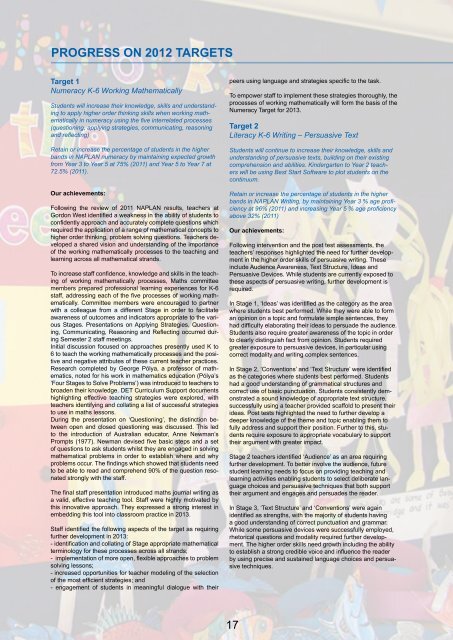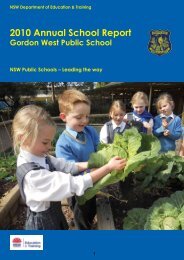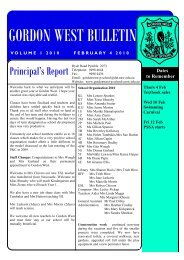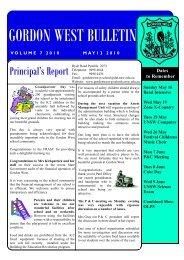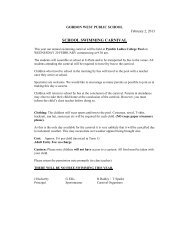2012 Annual School Report - Gordon West Public School
2012 Annual School Report - Gordon West Public School
2012 Annual School Report - Gordon West Public School
You also want an ePaper? Increase the reach of your titles
YUMPU automatically turns print PDFs into web optimized ePapers that Google loves.
PROGRESS ON <strong>2012</strong> TARGETS<br />
Target 1<br />
Numeracy K-6 Working Mathematically<br />
Students will increase their knowledge, skills and understanding<br />
to apply higher order thinking skills when working mathematically<br />
in numeracy using the five interrelated processes<br />
(questioning, applying strategies, communicating, reasoning<br />
and reflecting)<br />
Retain or increase the percentage of students in the higher<br />
bands in NAPLAN numeracy by maintaining expected growth<br />
from Year 3 to Year 5 at 75% (2011) and Year 5 to Year 7 at<br />
72.5% (2011).<br />
Our achievements:<br />
Following the review of 2011 NAPLAN results, teachers at<br />
<strong>Gordon</strong> <strong>West</strong> identified a weakness in the ability of students to<br />
confidently approach and accurately complete questions which<br />
required the application of a range of mathematical concepts to<br />
higher order thinking, problem solving questions. Teachers developed<br />
a shared vision and understanding of the importance<br />
of the working mathematically processes to the teaching and<br />
learning across all mathematical strands.<br />
To increase staff confidence, knowledge and skills in the teaching<br />
of working mathematically processes, Maths committee<br />
members prepared professional learning experiences for K-6<br />
staff, addressing each of the five processes of working mathematically.<br />
Committee members were encouraged to partner<br />
with a colleague from a different Stage in order to facilitate<br />
awareness of outcomes and indicators appropriate to the various<br />
Stages. Presentations on Applying Strategies, Questioning,<br />
Communicating, Reasoning and Reflecting occurred during<br />
Semester 2 staff meetings.<br />
Initial discussion focused on approaches presently used K to<br />
6 to teach the working mathematically processes and the positive<br />
and negative attributes of these current teacher practices.<br />
Research completed by George Pólya, a professor of mathematics,<br />
noted for his work in mathematics education (Pólya’s<br />
‘Four Stages to Solve Problems’) was introduced to teachers to<br />
broaden their knowledge. DET Curriculum Support documents<br />
highlighting effective teaching strategies were explored, with<br />
teachers identifying and collating a list of successful strategies<br />
to use in maths lessons.<br />
During the presentation on ‘Questioning’, the distinction between<br />
open and closed questioning was discussed. This led<br />
to the introduction of Australian educator, Anne Newman’s<br />
Prompts (1977). Newman devised five basic steps and a set<br />
of questions to ask students whilst they are engaged in solving<br />
mathematical problems in order to establish where and why<br />
problems occur. The findings which showed that students need<br />
to be able to read and comprehend 90% of the question resonated<br />
strongly with the staff.<br />
The final staff presentation introduced maths journal writing as<br />
a valid, effective teaching tool. Staff were highly motivated by<br />
this innovative approach. They expressed a strong interest in<br />
embedding this tool into classroom practice in 2013.<br />
Staff identified the following aspects of the target as requiring<br />
further development in 2013:<br />
- identification and collating of Stage appropriate mathematical<br />
terminology for these processes across all strands;<br />
- implementation of more open, flexible approaches to problem<br />
solving lessons;<br />
- increased opportunities for teacher modeling of the selection<br />
of the most efficient strategies; and<br />
- engagement of students in meaningful dialogue with their<br />
peers using language and strategies specific to the task.<br />
To empower staff to implement these strategies thoroughly, the<br />
processes of working mathematically will form the basis of the<br />
Numeracy Target for 2013.<br />
Target 2<br />
Literacy K-6 Writing – Persuasive Text<br />
Students will continue to increase their knowledge, skills and<br />
understanding of persuasive texts, building on their existing<br />
comprehension and abilities. Kindergarten to Year 2 teachers<br />
will be using Best Start Software to plot students on the<br />
continuum.<br />
Retain or increase the percentage of students in the higher<br />
bands in NAPLAN Writing, by maintaining Year 3 % age proficiency<br />
at 96% (2011) and increasing Year 5 % age proficiency<br />
above 32% (2011)<br />
Our achievements:<br />
Following intervention and the post test assessments, the<br />
teachers’ responses highlighted the need for further development<br />
in the higher order skills of persuasive writing. These<br />
include Audience Awareness, Text Structure, Ideas and<br />
Persuasive Devices. While students are currently exposed to<br />
these aspects of persuasive writing, further development is<br />
required.<br />
In Stage 1, ‘Ideas’ was identified as the category as the area<br />
where students best performed. While they were able to form<br />
an opinion on a topic and formulate simple sentences, they<br />
had difficulty elaborating their ideas to persuade the audience.<br />
Students also require greater awareness of the topic in order<br />
to clearly distinguish fact from opinion. Students required<br />
greater exposure to persuasive devices, in particular using<br />
correct modality and writing complex sentences.<br />
In Stage 2, ‘Conventions’ and ‘Text Structure’ were identified<br />
as the categories where students best performed. Students<br />
had a good understanding of grammatical structures and<br />
correct use of basic punctuation. Students consistently demonstrated<br />
a sound knowledge of appropriate text structure,<br />
successfully using a teacher provided scaffold to present their<br />
ideas. Post tests highlighted the need to further develop a<br />
deeper knowledge of the theme and topic enabling them to<br />
fully address and support their position. Further to this, students<br />
require exposure to appropriate vocabulary to support<br />
their argument with greater impact.<br />
Stage 2 teachers identified ‘Audience’ as an area requiring<br />
further development. To better involve the audience, future<br />
student learning needs to focus on providing teaching and<br />
learning activities enabling students to select deliberate language<br />
choices and persuasive techniques that both support<br />
their argument and engages and persuades the reader.<br />
In Stage 3, ‘Text Structure’ and ‘Conventions’ were again<br />
identified as strengths, with the majority of students having<br />
a good understanding of correct punctuation and grammar.<br />
While some persuasive devices were successfully employed,<br />
rhetorical questions and modality required further development.<br />
The higher order skills need growth including the ability<br />
to establish a strong credible voice and influence the reader<br />
by using precise and sustained language choices and persuasive<br />
techniques.<br />
17


